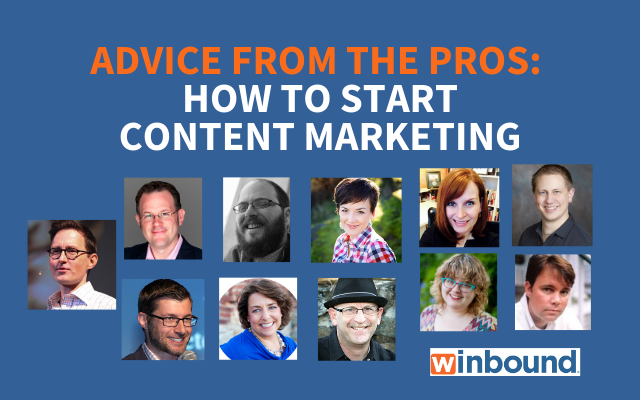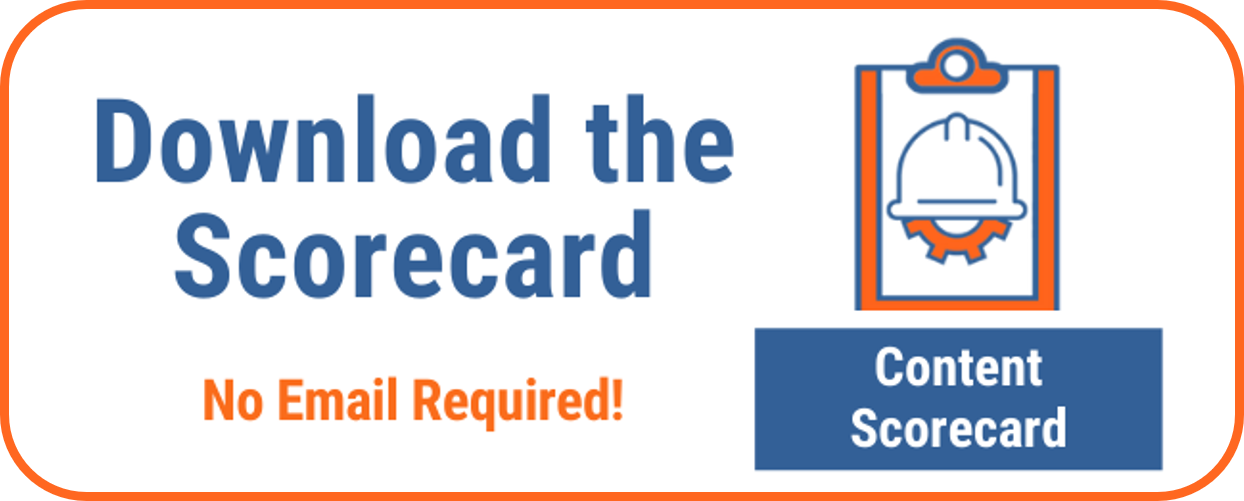Wondering how to start content marketing? We tapped some top experts (and included our own tried-and-true approach) to give you sound advice on how to start — and sustain — your content marketing efforts.
Getting started with content marketing includes six steps:
1. Set your content marketing goals
2. Build your persona by TALKING with your customer
3. Develop your customer journey and map your keyword research
4. Set your strategy, channels and tools
5. Create your editorial calendar and a few pieces of content
6. GO!
Let’s delve into each of these areas, with some help of some of the smartest content marketing folks in the business.
1. Set your content marketing goals
Self-help guru Tony Robbins said it best, “Setting goals is the first step in turning the invisible into the visible.”
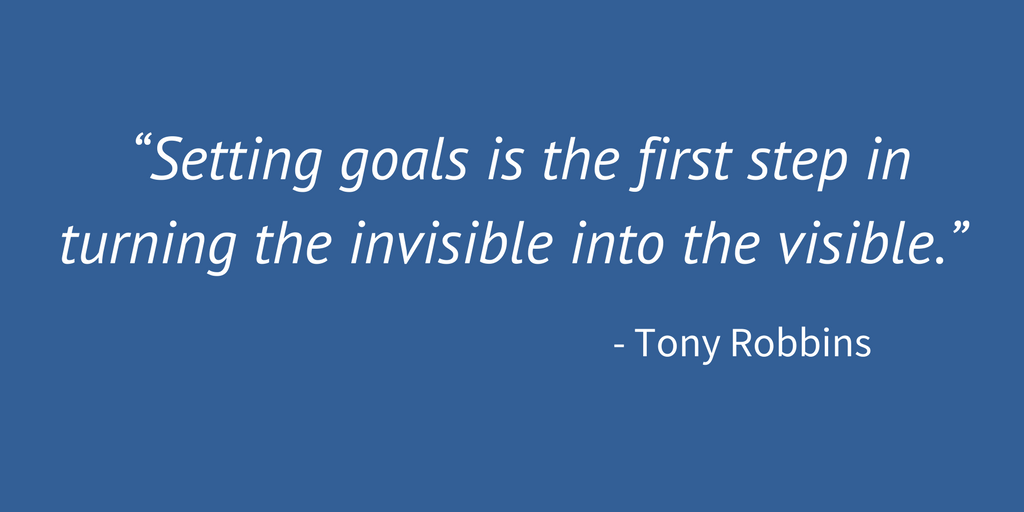
Content marketing can be an overwhelming beast. It’s often hard to imagine what your company should do, with so many different avenues you could take. Do you start a blog? Do you launch a YouTube channel? Do you start a LinkedIn group?
Naturally, you’re going to focus on a few fundamental goals: You want to increase traffic, and turn that traffic into leads and sales.
But what does it take to make that happen? It’s no surprise that the most input we received from content marketing experts focused on setting goals that make achieving traffic, leads and sales possible.
For example, Sean Callahan, Senior Manager – Content Marketing at LinkedIn, stresses the importance of building your audience.
With AI, AR, VR, and other shiny new objects, I fear that many content marketers are losing sight of what’s important. The key to assessing the health of your content and its reach is your blog.
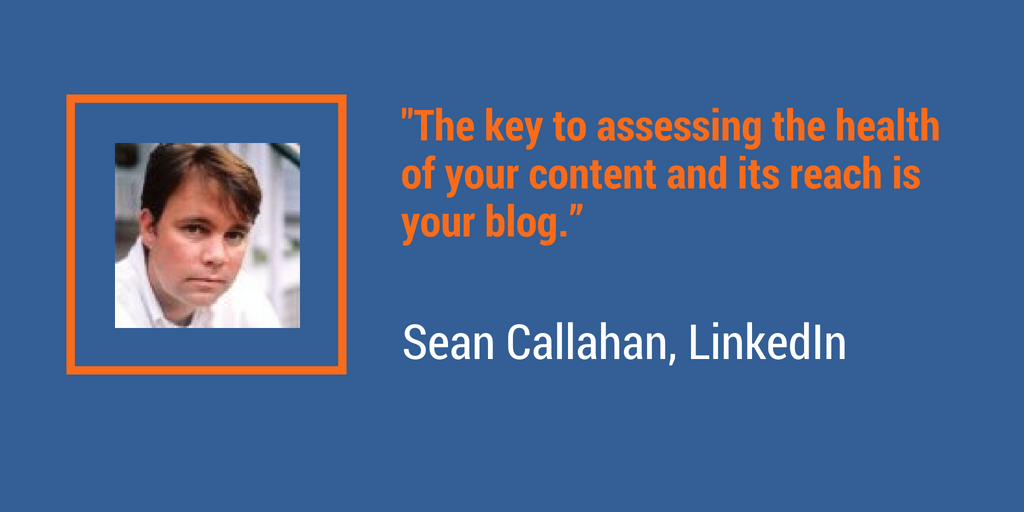
You can measure the health of your blog (and the content that appears on it) by how many people in your target audience are willing to provide their email address to subscribe to it. Subscribers are a key metric for content marketers.
To build an email list of people who value your content, Barry Feldman of Feldman Creative believes a goal should be to create “big content.” This is a powerful lead magnet that people will need to provide an email to get.
Unless your content is off-the-charts remarkable and you rule search, you can’t depend strictly on a blog and a newsletter opt-in. Create something great and require an email address to access it.
I’m talking about a powerful lead magnet, most notably, an ebook that answers pressing questions and positions you as an authority. Also, learn how to promote your lead magnet to attract real prospects.
In most industries, content wars are in full tilt. Quadruple-down on big content that will help you achieve your most important objectives.
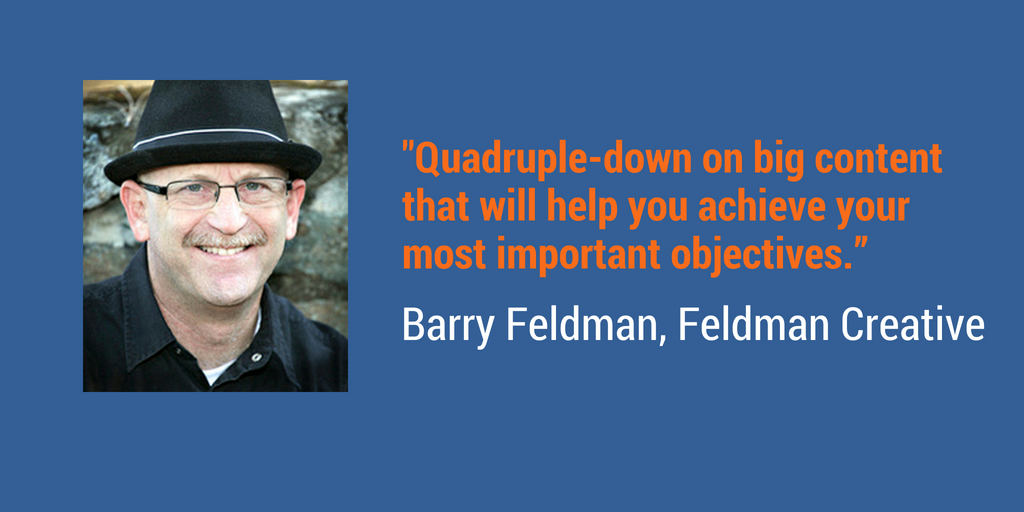
Real success in content marketing is long-term success. As Andy Crestodina of Orbit Media explains, a goal for your organization can be to commit to an extended length of time.
Because the benefits of content marketing are durable, the more you do them, the better the results. Search optimization, social media and email marketing are all powered by links, followers and subscribers respectively.
Stay active in these channels and the results get easier. The same time and effort will keep producing better and better results.
Another somewhat intangible but definitely measurable goal is consistency.
Gini Dietrich, CEO – Arment Dietrich and founder and author of Spin Sucks, agrees that committing to the content marketing “long-game” is essential, and requires passion and desire.
So let’s say you have the passion for it and you have the runway to test things and get them right, I would first start with consistency. The most important thing you can do is deliver something, when you say you’re going to do it.
For instance, you do not want to provide a great lead magnet and then not have any follow-up until your sort of quarterly, if you get to it, newsletter.
Figure out where you’re going to start — Facebook Live, a blog, lead magnets, podcast, other great content ideas — and create a calendar so you are consistent. It can be once a week, bi-weekly, once a month, or every day.
The point is to be consistent. Once you get that one thing down, you can grow from there. And it doesn’t matter if you have a team of 3,000 or if it’s just you. If you get the consistency right, the rest will follow.
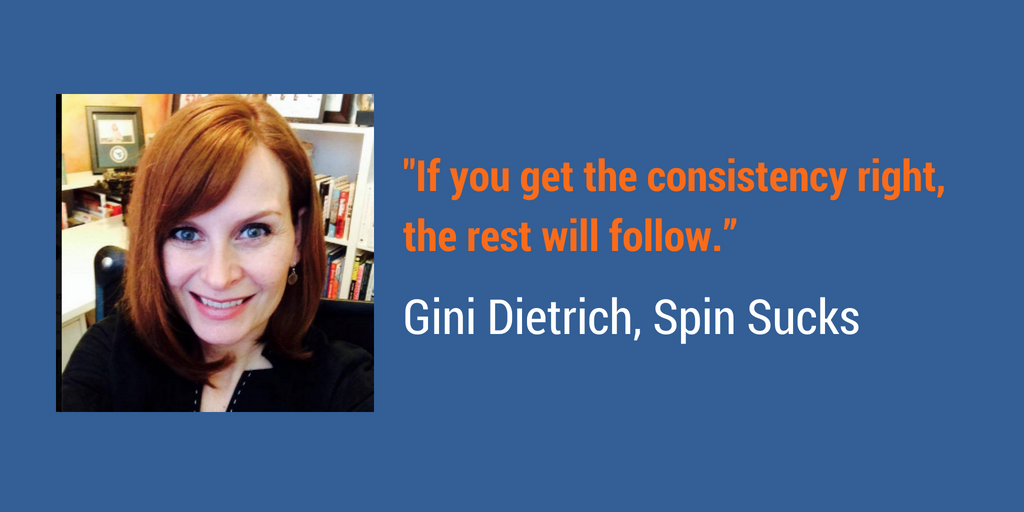
So true, Gini. When we first started out in content marketing, the one thing we always stressed was getting that content out. And for the clients who worked with us to achieve those goals, the results always followed.
2. Build your persona by TALKING with your customer
If anything is mission-critical in this whole ball of wax, it’s to fully understand your customer, and develop a persona that you can refer to when creating content.
As marketers, we get so wrapped up in what our company is telling us to do and what the marketing gurus out there are telling us to do, that we forget what our customers are telling us to do.
Matt Jacoby of Octave Media agrees.
I would tell any small marketing team to really understand their customer first to ensure that their marketing efforts always stay customer-centric versus business-centric / internal-needs-centric.
Thinking about who’s on the other end overthinking about how to get your “forced or pushed message” out is going to make content marketing work that much faster.
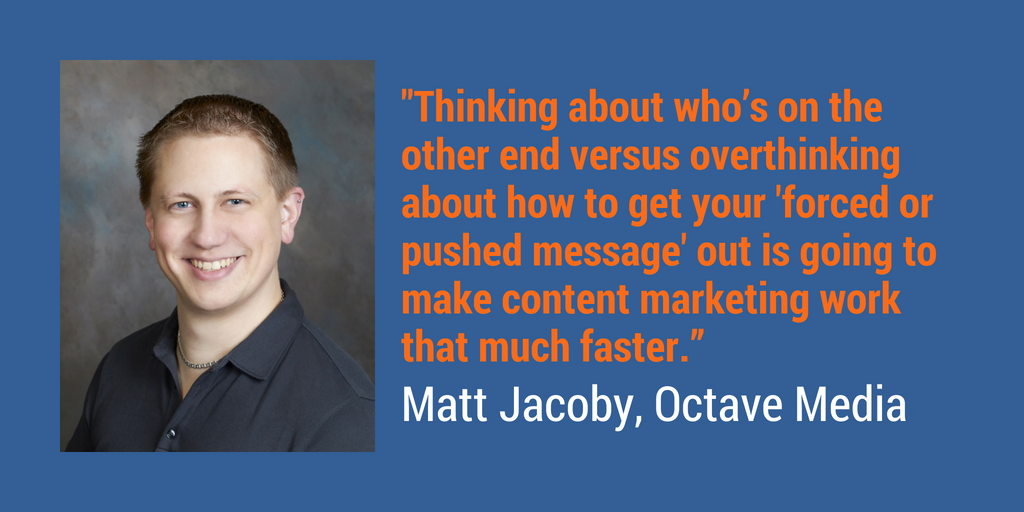
If you talk about yourself all the time, chances are no one is going to listen and you won’t make any progress.
Now, I’m not just talking about your idea of what your customer thinks. I’m talking about using data to really understand them. Andy Crestodina explains:
Your audience is constantly telling you what content they want from you. Sales conversations, chat logs, keyphrase research and analytics. These are all sources of data-driven empathy. You just need to listen.
The right topic will get 10x the results. So one of the keys to marketing efficiency is to use data to find great blog topics.
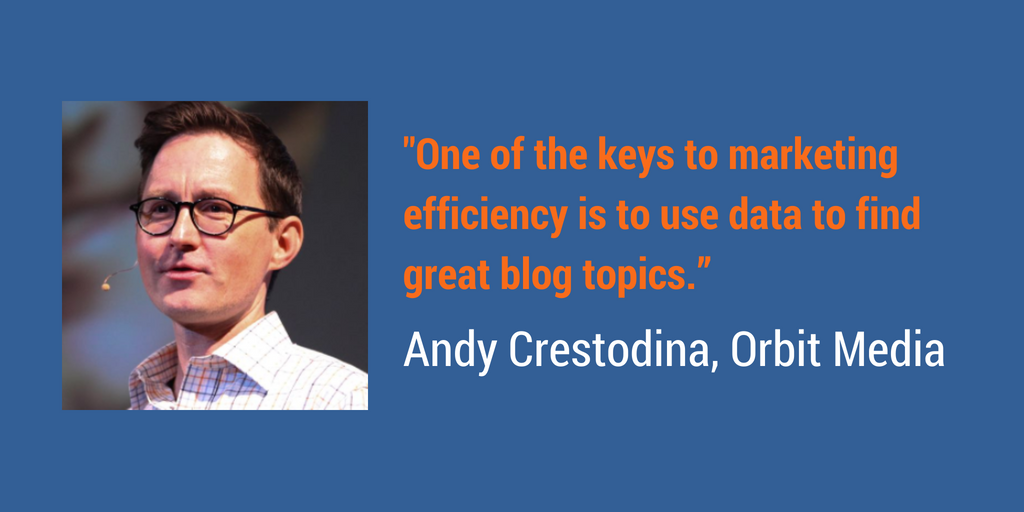
For a small marketing team that doesn’t have tremendous resources, one highly effective tool we’ve used is “guerilla research.”
We conduct a series of one-on-one interviews with as few as three clients, and then analyze their responses for converging needs and wants. We actually TALK with the customers. (Imagine that.)
Once you’ve established that persona, you need to be persistent in reaching them with the message. So sayeth David Fisher, sales consultant and author of Hyper-Connected Selling:
Know who your audience is, where they are, and what type of message they respond to, and then be diligent about putting your attention there. Be OK with repetition.
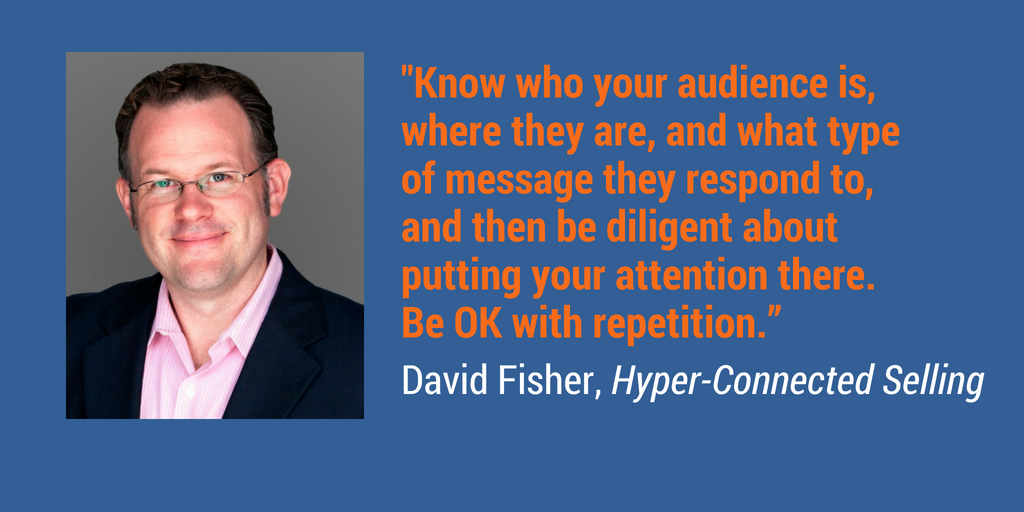
It can take a while for a message to seep into your audience’s consciousness in this noisy world, and often we tire of putting our message out before it’s really had its effect. So keep pushing.
DFish is right. It’s akin to the notion of traditional advertising: Frequency is important to get your message through.
3. Develop your customer journey and map your keyword research
Ok, you’ve mapped out your persona and committed to communicating with that segment regularly. Now what?
Produce content that really matters to them. Darcy Eikenberg, Executive & Leadership Coach, explains:
How can you make a difference with your best clients or customers? How can you do something that matters to them — that challenges them, encourages them, or gives them peace of mind?
It sounds heady but all good content marketing starts with the goal to serve. Your audience is savvy — if you’re trying too hard to convince them to buy, they smell it and their defenses go up. (You know it’s true — you do it yourself!)
But we can feel when someone’s generous and caring and in it for the long game, not the short-term kill.
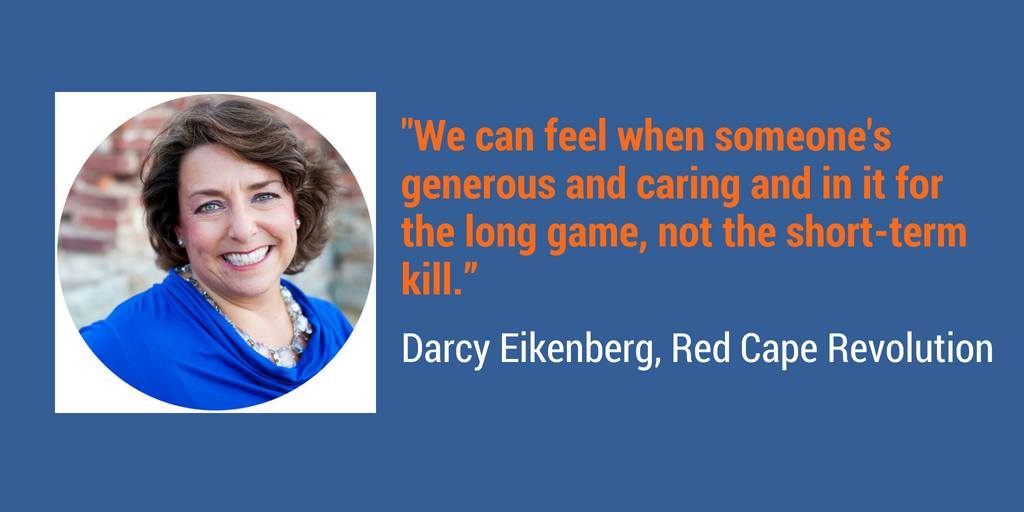
Those companies are the ones we continue to allow in our inbox, engage with, and ultimately, trade our hard-won dollars for the result you promise.
So how you do you begin to earn your target persona’s trust?
Essentially, you need to meet them at the top of the customer journey. You need to meet them before they even realize they need your product or service.
That involves getting on their radar by sharing content and solving problems about issues they care about — even if your product is far on the periphery at the moment. We call that “No Problem” awareness, as noted in the Customer Journey graphic below.
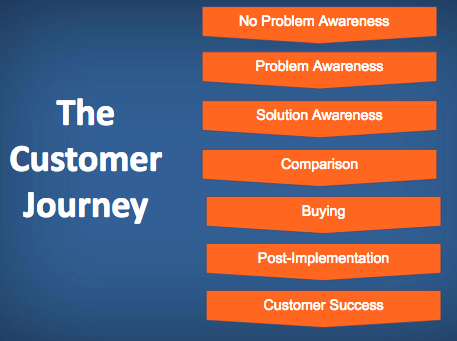
In our post on mapping keywords to your customer journey, we shared an example of a company selling “Shark Repellent.” If you own that company, you want to produce content about how shark repellent works, how to use it, etc.
But first, you need to create awareness among potential customers with content that might interest them even before they begin taking the customer journey — the one that ends when they purchase and use shark repellent.
Maybe you’re talking about keywords such as “great places to vacation,” or even “not-so-safe places to travel.” That content will help lead people down the journey. (Check out our post on how to integrate keyword research into your customer journey map.)
Using keywords, and mapping them to the customer journey, also reveals what people are searching for — a great way to help you prioritize exactly what you should be talking about in your content.
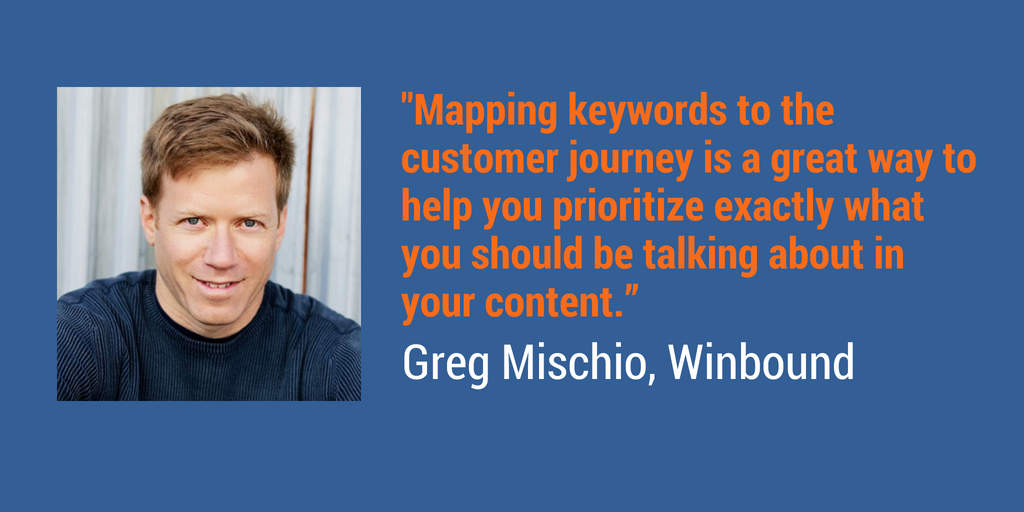
4. Set your content marketing strategy and channels
When you’ve set your goals, built your persona, and mapped the customer journey, we find it’s much easier to get creative in developing your strategy and content marketing channels.
The strategy practically writes itself when you get the data — you just get to be creative in the execution.
In this case, the strategy doesn’t need to be complicated. State simply what your goals are, the persona you’re trying to reach, and then the strategy for trying to reach them.
Just a one-page, simple strategy that you can refer to time and time again is more than enough.
As noted in our post on what makes a successful marketer, “Marketers who document their strategy are 5.38 times more likely to report success than those who don’t.”
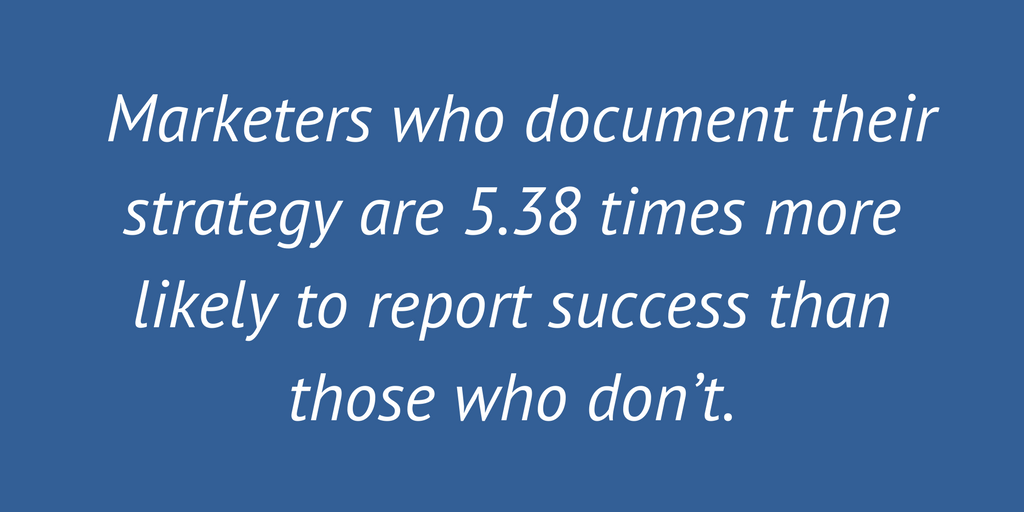
Now it’s time to decide on the content marketing channels — blogging, guest-blogging, videos, etc. As you’re looking for areas to publish content, keep in mind David Fisher’s tip:
It’s important that a small marketing department (especially if it’s just you) focuses intentionally on a few key activities.
It’s easy to become distracted by the huge number of marketing options available, but if you spread yourself too thin, it’s hard to get critical mass in any area.
There are a lot of shiny new objects in marketing. But remember that there are no silver bullets and that that you don’t have the time or resources to chase every new trend and fad.
Sarah Best of Sarah Best Strategy explains that you can make use of multiple channels through smart content planning up front.
There are few ways teams can be a little more time efficient when they are first starting. The first is to work off of a content plan, and then to consider the question of how to distribute that content separately.
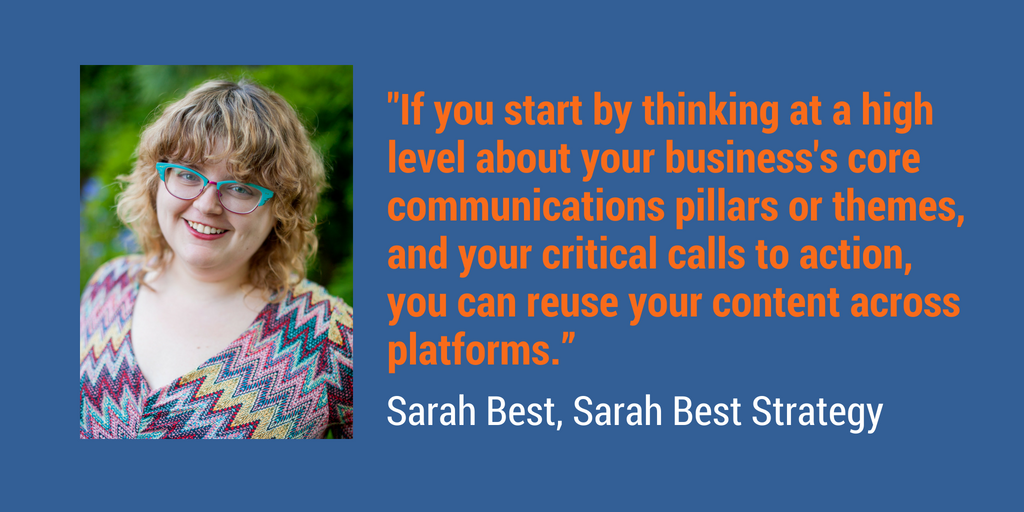
If you start by thinking at a high level about your business’s core communications pillars or themes, and your critical calls to action, you can reuse your content across platforms.
Coming up with two content topics, you can create two pieces of web content, a newsletter that teases both of those pages, and then four or more social media posts pulling out facts or questions from the same pieces.
There are a few added benefits to this approach. The first is that by focusing your planning efforts at a high level, rather than getting bogged down in the details of execution, you can involve more people in planning such as executives and people who are on the “front line” with clients, like sales and customer support staff.
The second is that you’ll be more time efficient. The third is that creating consistent touchpoints across channels reinforces your branding through consistency and repetition. It increases the chances that your customer will develop awareness of your content, and take any actions you’d like them to take.
That’s golden advice.
When it comes to choosing channels, look outside the box — specifically, your own. Spencer X. Smith of spencerXsmith.com and AmpliPhi, explains:
Every industry has at least one core publication focused on serving a very specific audience.
Before the mass adoption of the web, this took the form of newsletters or magazines. These analog forms of media only had finite space available, and to reach that publication’s readers, you would need to buy advertising space.
Now, each of these publications have a website meant to serve that same specific audience, and their content needs have increased tenfold.
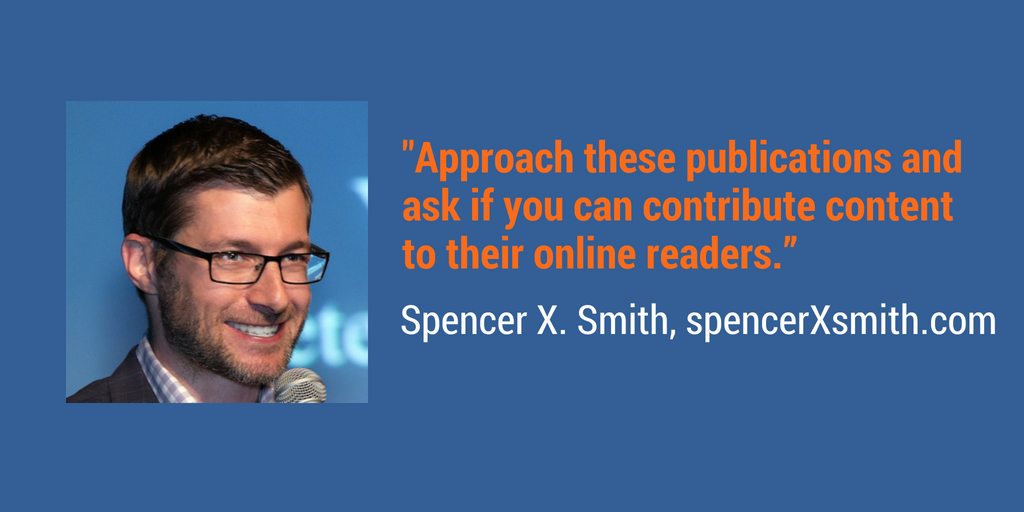
I suggest approaching these publications and asking if you can contribute content to their online readers. This works extremely well for three reasons:
1. Because you’re offering content for their readers, you get to reach the audience for free (instead of buying advertising space)
2. Many publications do not require original content for their readers. You can repurpose articles you’ve already written for other outlets
3. As you’re approaching prospective customers in that industry, you can use the articles you’ve written in your drip campaigns to showcase your expertise
By following this simple strategy, I now contribute articles to publications in two of my niche industries (legal and financial services), and have a column with a local business magazine.
Total advertising budget for reaching my target audience? Zero.
It’s a smart move, and Spencer is reaping the benefits.
For a small marketing team, it may all come down to bandwidth and resources. And there’s a lot to be said for really understanding a channel and mastering it. Joanna Wiebe of Copyhackers explains:
Commit to one “kind” of content marketing — like one channel — for one year. Fully commit. In that year, all of your content marketing efforts will be put into creating and promoting content for that one channel.
During the course of that year, you are not allowed to give up on CM or let your course be shifted by any of the following: excuses, frustration, slow results, inconsistent results, distracting trends, distracting case studies, self doubt, CEO doubt, boardroom-table hate fests, creation fatigue, shiny object syndrome or good ol’ fashioned laziness.
By the time the year ends, you WILL have pushed through the really hard parts, gained a level of mastery over one channel and achieved the kind of discipline that will help you as you add your next CM effort to the mix.
Small teams can’t afford to be wishy-washy. So commit, commit, commit. And if you can’t commit, don’t even THINK about content marketing.
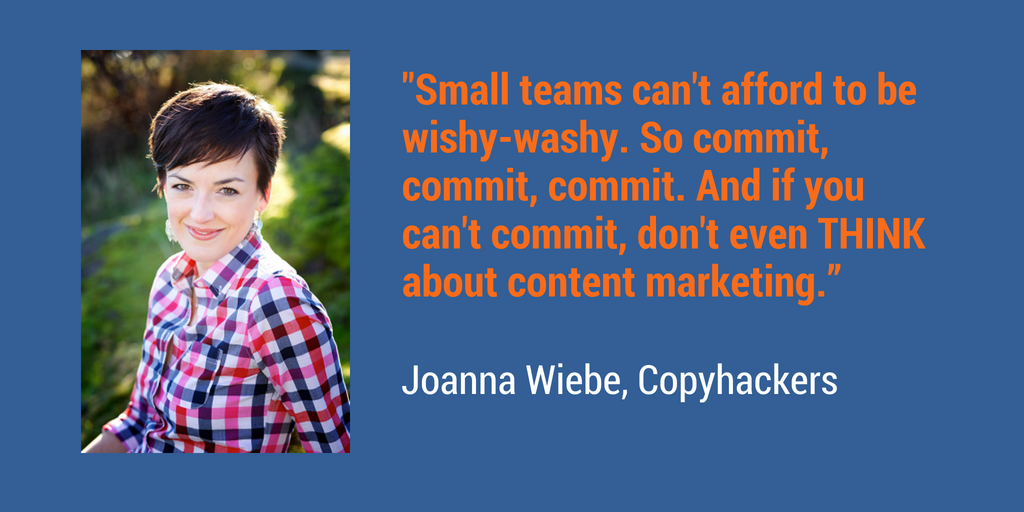
5. Create your editorial calendar
Now that you have all your ducks in a row, it’s time to plan out that content. You’ve got a boatload of data — now spend a few hours with your team plotting out the calendar for the year.
As Sarah Best noted earlier, pre-planning makes all the difference. You can prioritize posts according to:
- Potential for search engine ranking
- Timely events
- Related product and service launches
Your planning should also include who you plan on collaborating with for these pieces of content. Content collaboration is extremely important for your overall success — we explain how that works in this post.
All this planning is important because if it’s overlooked, you’ll spend too much time and effort scrambling to create the content. Josh Klemons, Digital Storyteller/Strategist and the founder of Reverbal Communications, elaborates:
When inspiration strikes, by all means, create content. But more often than not, content creation isn’t about inspiration, it’s about making the time.
Keep a running list of ideas that you can turn into blog posts (or videos, or infographics or whatever you do). Then when you have time, simply pull something off the list and get to work.
Otherwise, you’ll get motivated, and then waste the little bit of time you had trying to come up with an idea, rather than actually working on content.
Things to put onto your running list: FAQs, updates to the field, tips and tricks and anything else you come across throughout the day that you think might be helpful to your audience.
6. Go forth and publish!
All that hard work gets you to the fun stuff: creating and publishing.
But don’t be fooled; content marketing is hard work. It takes discipline and focus. You and the team will need to block out the distractions and always publish, publish, publish. Believe me, the rewards will be worth it.
EXTRA BONUS: Intangibles to keep in mind
We’ve shared a lot of great insights from expert contributors. We wanted to include some intangibles to keep in mind.
David Fisher stresses collaboration (so do we!):
Find ways to magnify your efforts through technology. Look at your list of responsibilities and see if there are areas where an online SaaS program or the like can inexpensively save you some time. For example, is there a social media manager that can help you leverage your time by automating the work?
And keep networking with other marketers! You’ll meet people who will give you insights and ideas that you can act upon.
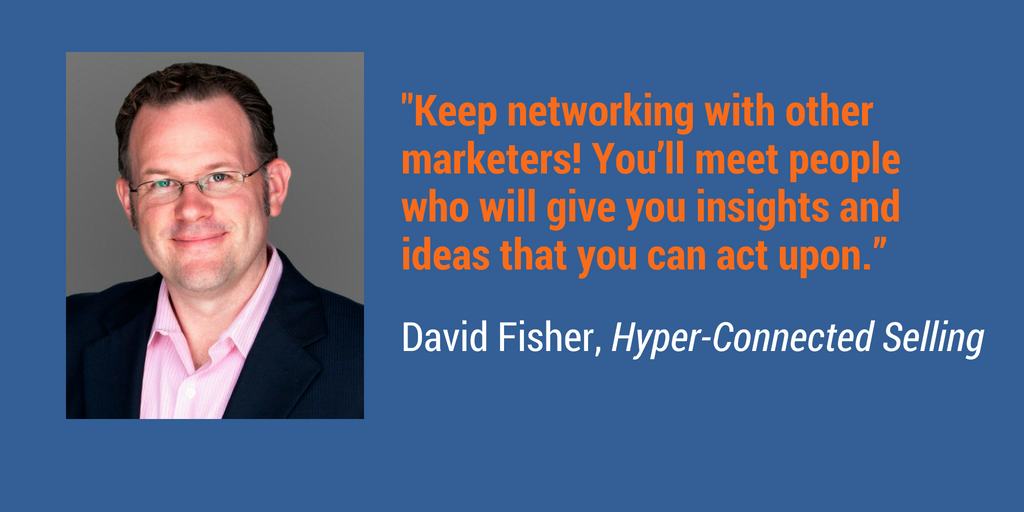
More importantly, you’ll find ways to collaborate as you create and share your marketing content. That can be a huge boost with little to no extra effort. Your messages will be more effective and you’ll have more fun in your work.
Hear, hear, David!
Next, Andy Crestodina says focus on efficiency:
I once met with a billion-dollar, publicly-traded national brand. They kicked off the meeting by telling me that they would like to do more with their marketing, but they have limited budgets. I realized in that moment that every company says this.
But some of us really are on micro-teams of just one or two people. At Orbit, everything we do is handled by just two people: Amanda and me. And I have other jobs that require my attention (selling websites, working on websites) so I’m really just a part-time marketer. That means there are just 1.5 of us.
But we do a lot of stuff with just that person and a half. Here’s a rundown of what we do in a year:
- Attract more than a million visitors
- Generate 1000+ leads
- Produce 15 events and an annual conference, Content Jam.
- Publish 50+ articles and a podcast
How is that possible? It’s all about efficiency.
1. The more you do something, the faster you get at it
Think of everything you do as a program. Programs have process and process means efficiency. The first time you do something is the slowest and worst job you’ll ever do on that project. Do something 100 times and you’ll fly through it. Quality and efficiency both improve.
2. Network, collaborate and co-create
You should always be meeting and collaborating with new people. Grow your network and work with others.This is the key to influencer marketing, quality content and fun.The best marketers fill their content with experts and influencers. This makes both creation easier (here I am, doing Greg’s writing homework for him) and promotion easier (I can’t wait to share this when it goes live!).
There are a LOT of other reasons why small teams kick ass. They use automation and scheduling tools to reduce repetitive tasks. They do work in batches. They leverage virtual assistants. They cancel programs that fail. They don’t spent a lot of time in meetings. And they work very well together. Nothing wastes more time than friction between team members.
So true. And Sarah Best encourages you to plan green — evergreen!
Create some content that is evergreen. Evergreen content never goes out of date. Accountants, for example, are always going to remind people to contribute to their retirement accounts at the same time of year, or to make charitable donations, or to come in for their annual tax preparation.
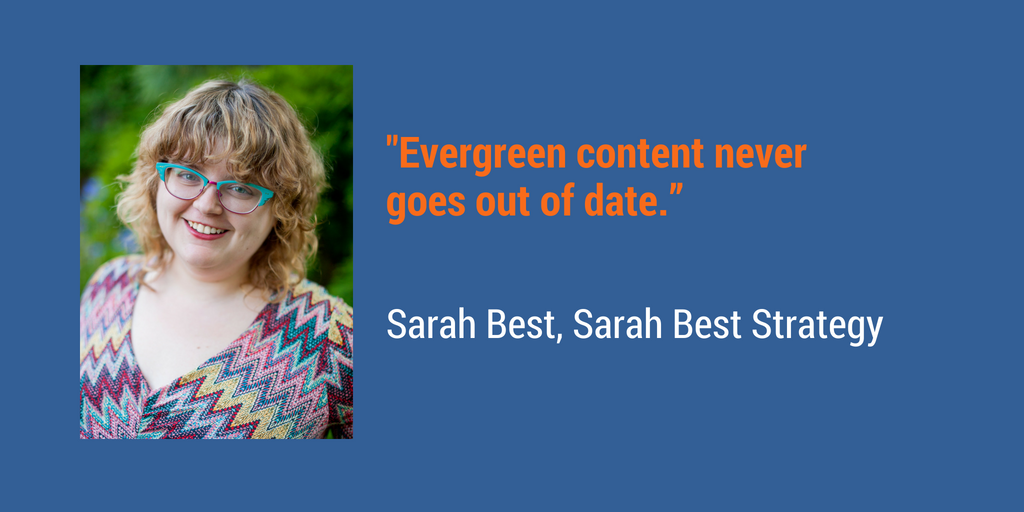
You don’t have to rewrite that stuff every time you post it. Evergreen content is your recurring calls to action, like “Sign up for our newsletter.” It’s the stuff that lives on the top-level pages of your website.
If you write content based on those pages and organize it in a spreadsheet you can reuse it, note when you’ve last used it, and adapt or freshen it up over time.
Finally, Josh Klemons reminds us that it’s all about educating. Marketing today requires you to not always be a marketer!
No matter how tapped into your market your audience is, they are not following the ins and outs as closely as you are! Use your digital channels to educate your audience — they’ll love you for it.
Don’t be a marketer, just asking for the sale. Be a content marketer, teaching, engaging and building relationships. Don’t be afraid to give away your secrets. The more your audience learns from you, the more they will see how amazing you really are.
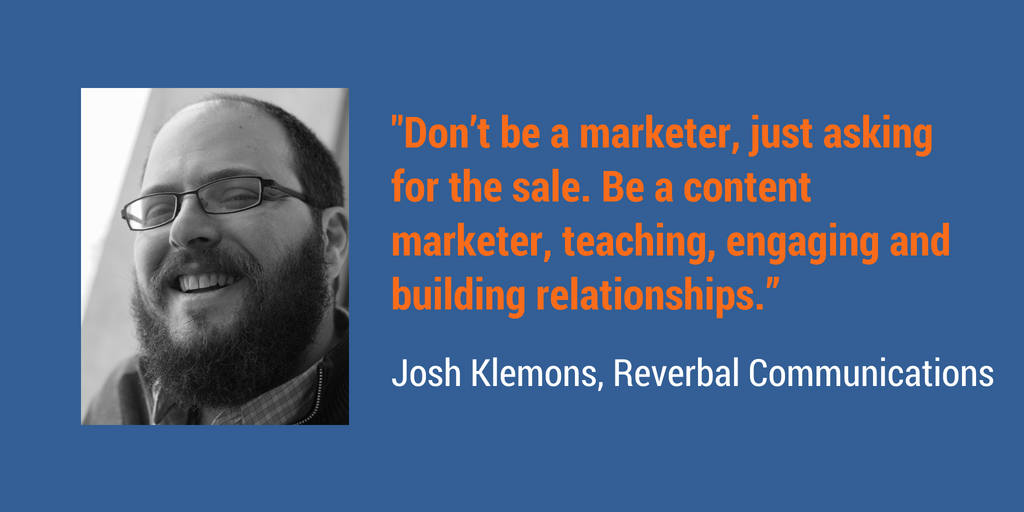
As for Winbound’s secret sauce, we believe content collaboration is far and away one of the most important things you can do once you move into the execution phase, as DFish noted above.
Motivational quotes to give you that final push — including one from dear old Dad
Ok, you’ve got the framework to get the ball rolling. Here are a couple motivational quotes to give you that last push:
“The secret of getting ahead is getting started.” – Mark Twain
“The way to get started is to quit talking and begin doing.” – Walt Disney
“If you don’t clean your room, you won’t get your allowance.” – George Mischio
Man, that last one always got me moving. Dad is right. You want results, content marketing will get you there, which gets you paid. It’s just a matter of getting started.
Find out how your content and conversion ranks with our interactive version of the Content Scorecard you can fill in yourself – no email required for download.
